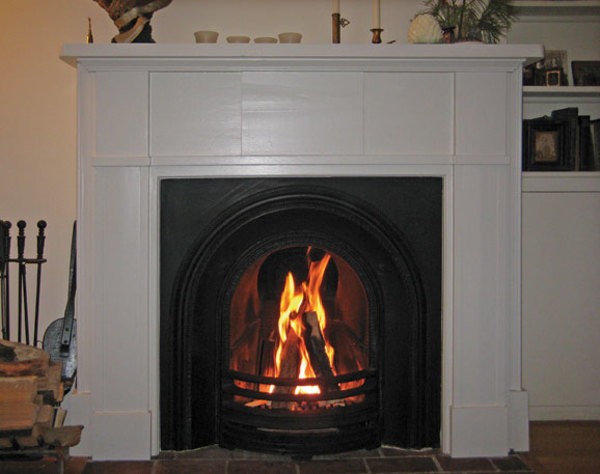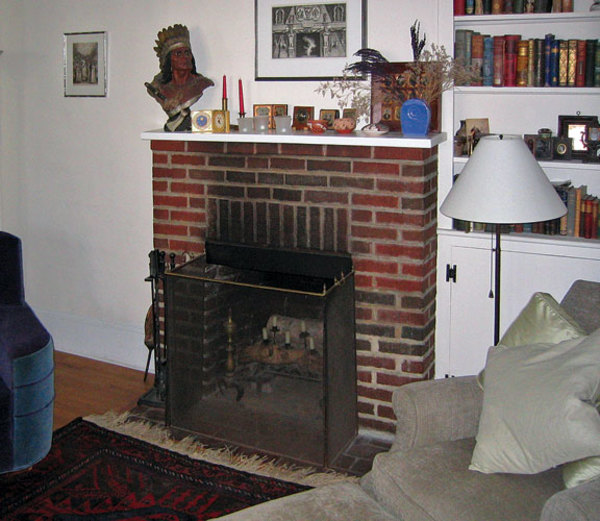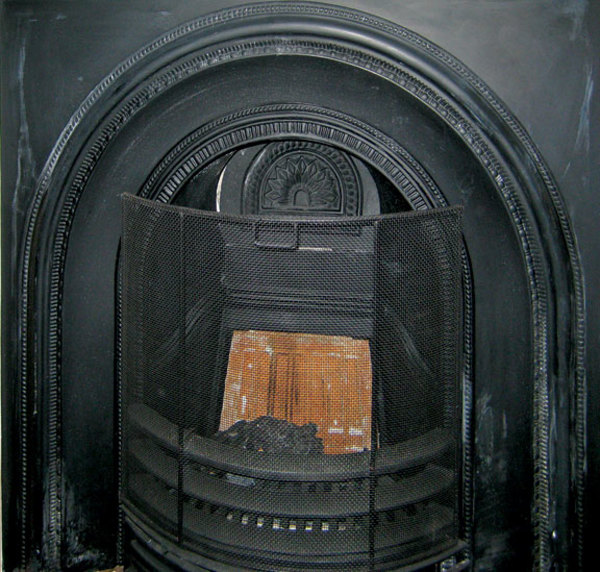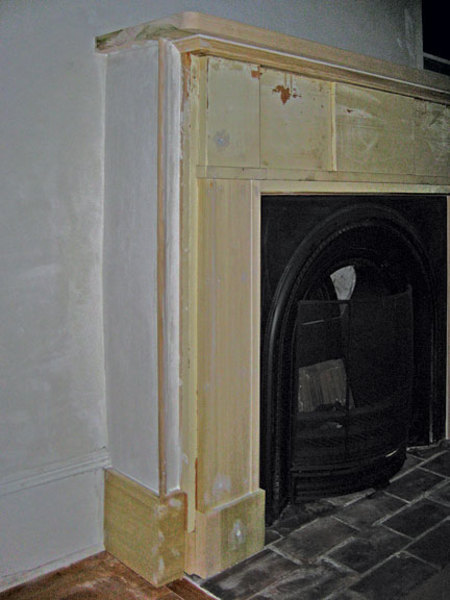
The restored fireplace, with a new insert and two cast-in-place flue liners in the chimney, now safely vents two appliances—hot water heater and boiler—in addition to holding a crackling fire.
When central heating was installed in pre-Victorian houses, it was often at the expense of an original wood-burning fireplace. The new heating system, powered by coal and later oil, needed a flue to vent the byproducts of combustion. The easiest solution was to punch a hole in the brick hearth (fireplace floor) nearest the furnace or boiler, route a metal duct through the flue, and brick up the mouth of the affected fireplace. Voila, the homeowners had central heat and an end to the drudgery of heating with fireplaces. I’m sure our forebears felt that sacrificing a fireplace for the modern convenience of central heat was no sacrifice at all, but today’s old-house enthusiasts may not agree. Getting a central-heat-retrofitted fireplace back to good wood-burning order is a job best tackled through a series of methodical steps.
Bringing it Back
When the Friedman-Sorenson family, owners of an 1860 Greek Revival worker’s cottage, contacted me, their boiler maintenance company had just informed them that their boiler’s venting system had become dangerous. Acidic effluents from decades of boiler use had eaten away significant portions of the brick mortar above the roofline and in the third floor area of the house. Their unlined brick chimney—which had been reconfigured to vent the boiler—was becoming structurally unsound.

Before the project, the fireplace could only safely hold lighted candles, and its brick mantel didn’t match the home’s architecture.
In addition, holes that had worn through the mortar on the third floor could allow potentially deadly carbon monoxide to enter the living area. The Friedman-Sorensons wanted the chimney repaired, and they also hoped to get the fireplace in good working order since the flue’s reconfiguration caused the fireplace to smoke up the room whenever it was used.
The masonry flue needed to be lined, and we decided to use a cast-in-place liner. (For more about lining chimneys, see Making Sense of Chimney Liners.) The original chimney was large enough to accommodate a 6″ round flue to vent the boiler and hot water heater, which would protect the masonry chimney, provide a superior draft for the appliances, and close all potential holes through which carbon monoxide might escape. But getting the fireplace working again was a different story. While we could fit another 6″ round liner in the existing space, at 30″ wide, the fireplace needed at least a 9″ round flue to work properly.
To solve the problem, I suggested installing a Victorian cast iron wood-burning insert capable of drafting through a 6″ round flue. As an added bonus, the stove’s backplate would cover up the plain and inappropriate brick fireplace surround that detracted from the home’s original charm.
The Work
To restore the chimney’s structural integrity, my team repointed it above the roofline and closed holes in the mortar joints on the third floor. In order to access the third-floor spots, we had to break through—and then repair—an interior wall, but fortunately we were able to do this through a closet. We also raised the mechanical flue’s connection to the chimney in the fireplace throat so that it didn’t turn so abruptly into the flue. Then we dropped two 6″ inflatable rubber forms—like big balloons—down the existing chimney. Each had 1″ springs crimped around it at 24″ intervals along the tube to keep the forms off the chimney’s brick walls and separated from each other.

The new Victorian-style fireplace insert fit the space well, but its backplate didn’t completely conceal the old brick.
The first form was lowered down the chimney and over to the basement boiler’s flue thimble. The second form was dropped down the fireplace itself. We removed the anachronistic 1980s-era brick mantel, and set the Victorian insert into the fireplace so we could pull the chimney form through the damper hole on the insert’s back side. We then secured and braced the insert.
Our crew set up the pump and mixer and slowly poured SolidFlue lightweight chimney refractory mortar around the two forms. (Poured chimney liners are all done with Portland-based, lightweight refractory mortars.) We vibrated the forms constantly using machines strapped to the formers to eliminate the potential for voids, and monitored the basement, fireplace, and third-floor closet areas for leaks. We poured for three days before reaching the top of the chimney—spreading out pouring time puts less pressure on the old chimney. A day after we finished pouring, after 12 hours of cure time, we deflated and removed the forms, leaving behind two smooth, continuous masonry flues. In addition to being rated for zero clearance to combustibles, the new flues created a lightweight reinforcing column inside the old masonry chimney.
The Finishing Touches

To create a seamless appearance, Charlie found a reclaimed wooden Greek Revival mantel and re-worked it, resizing its plinths and adjusting its height and depth to match the original molding and the built-in bookcase sitting beside it.
Next, we connected the boiler and hot water heater’s 6″ thimble to the new poured liner in the basement, and test-fired the Victorian insert to ensure that it was safe to burn wood, using a chimney camera to check that there were no voids or cracks. We verified that everything was safe and in good working order, but our job wasn’t quite finished yet—we still had to replace the 1980s-era brick mantel.
We found a reclaimed wooden Greek Revival mantel and set it over the backplate of the Victorian insert. We then resized the mantel plinths to properly receive the original baseboard and base molding, set a wood corner plaster ground, and repaired the front and return walls. We had to adjust the mantel’s height and depth to match the dimensions of an existing built-in bookcase that sat to the right of it.
Now, the relined chimney flues both exhaust the house’s mechanical systems and preserve the ambience of the open-hearth wood-burning fireplace. Not a bad fix for a favorite old-house part.
Want more information on historic hearths? Complement your old home with a reproduction fireplace.







